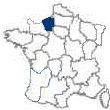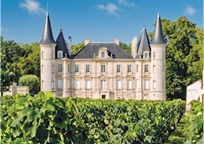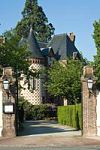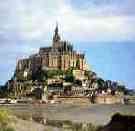|
|
|
|
The Region of Upper Normandy
- France Region 17
'Haute- Normandie'
Upper Normandy is composed of the Départements of Eure [27]
and Seine-Maritime [76] |
 |
|
|
The Regions of Upper Normandy
Region 17of 22 & Lower Normandy Region 16 of 22
|
|
Formerly a French province, Normandy [Normandie], with its old capital at
Rouen, is
now divided into two regions bordering on the
English Channel: Upper Normandy [Haute-Normandie] and Lower Normandy [Basse-Normandie]. During the Roman period, the region formed part of Gallia Lugdunensis (Celtic Gaul). With the Frankish invasions it was made a constituent part of the kingdom of Neustria.
Ten centuries have passed since the Vikings invaded the province of Normandy. The early Scandinavians might have come to ravish the land, but they stayed to cultivate it. It came to be known as Normandy about 911, when Charles III, king of France, turned it over to Rollo, the leader of a menacing band of Viking raiders.
The Normans produced great soldiers, none more famous than
William the Conqueror, who defeated the forces of King Harold at Battle Abbey in 1066. In 1066,William II, duke of Normandy [a descendant of Rollo], led an invasion of England and established himself there as William I, king of England. Consequently, Normandy remained an English possession until conquered in 1204 by
Philip II Augustus, king of France. During
the Hundred Years’ War, the region was held at various times by both French and English forces; it was finally recovered by the French in 1450. The Channel Islands, which were once a part of Normandy, remained in the possession of England. The English and the French continued to do battle, on and off for 700 years, from 1066 to the decisive Battle of Waterloo in 1815.
From Wellington’s defeat of Napoleon, Normandy remained at peace until June 6, 1944 when it was ravaged in the 1944 invasion that began early in the morning when airborne troops parachuted down into Ste-Mère-Eglise and Bénouville-sur-Orne. The largest armada ever assembled was responsible for the beginning of the reconquest of continental Europe from the Nazis. Today many come to Normandy just to see the D-Day beachheads.
Much of this province is reminiscent of a great landscape painting, with cattle grazing sleepily in verdant fields. But the rustic wood-framed houses are contrasted alongside the nearby modern buildings. Not far from the Seine, a mere hour drive from Paris, is Giverny where Monet painted his water lilies. Here and there you can still find stained-glass windows and Gothic architecture miraculously spared the bombardments; however, many great buildings were leveled to the ground. And Normandy’s wide beaches may attract families, but in August the Deauville sands draw the choicest of the chic from Europe and North America.
Normandy is the land of Calvados brandy and apple cider [bon bere]. It is well known for its rich butter, cream and other dairy products. The region is world renowned for its culinary tour de force: sauce Normande, tripe a la mode de Caen, sole Dieppe, canard a la Rouen, and soufflé like omelets from Mont-St-Michel. Poule d’Auge, poule de Bresse, andouillet (tripe sausage) de Vire, moules d’ Isigny, hueters de Courseulles, fuite de mer d’Honfleur, and the highly prized lamb (pré salé) that is raised on the salt meadows of Normandy.
Supple Camembert, which is made from cow’s milk, has been sold in a wooden box since 1880, is well known. Lesser known cheeses of the area, are equally tasty. These include Pont-L’Evêque and Brillat-Savanin. The latter with a high fat content of 75%, was invented in the 1930s by the cheese merchant Henri Androuët. His family established the once famous restaurant Androuët, on rue d’Amsterdam, in Paris, which specialized in sauces made from cheese.
Normans consume cider at nearly every meal. Bon bère is the term for true cider, and sometimes it’s so strong that it must be diluted with water. It takes 12 to 15 years to bring Calvados to taste perfection (in America Calvados may be called apple jack).
Many a Norman finishes a meal with black coffee and a glass of this strong drink, which is also used to flavor main courses.
The region of Upper-Normandy
is composed of the Départements
of Eure [27] and Seine-Maritime [76]. The region is
bounded by the Départements of Calvados and Orne to the
west, Eure-et-Loire to the south, and Yvelines, Val d'Oise,
Oise and Somme to the east. The English Channel lies
to the northwest. Haute-Normandie is mostly lowland
belonging to the Paris Basin and is drained by the River
Seine.
The
History of Upper-Normandy
Normandy takes it's name from the
Normans during the early middle ages. The Normans were a
mixture of Gauls and Vikings who laid siege to Paris under the
leadership of Rollo, thus he was given the area of Normandy in
return for his defense of the area against pirates.
William, the Duke of Normandy was Rollo's descendent, and in 1066 he
invaded England [the last to successfully invade England] and became
King William I of England. The area remained under English
rule until 1087. Several battles from 1106 through 1214 took place,
and during the
Hundred Years War Normandy was occupied by the English.
Normandy prospered
after the Hundred Years War and the Wars of Religion, due to the
fact that several major towns joined the Reformation, and more
battles ensued throughout Normandy. Normandy during the
French Revolution tended to support the Federal Republic rather than
that of the Jacobins in Paris.
Normandy was the turning point during World War II, with the
successful [but very costly in soldiers lives] D-Day invasion
of German occupation of France, by allied troops. To visit the
Normandy D-Day memorials and battlefield areas,
click here.
The
Geography of Upper Normandy
The Culture of Upper Normandy
Upper-Normandy's climate is wet. It is densely populated, but
the population declined slightly between 1851 and 1946, as in much
of rural France during that period. Immigration, and a
relatively high birth rate, have accounted for an increase since
World War II. This recovery has favored Seine-Maritime, whose
population is heavily concentrated in Le Havre, Rouen and small
urban centers along the Seine river.
The Gastronomy of
UpperNormandy
The gastronomy of Normandy in general tends to run to the
fish and seafood dishes, since it is fresh and abundant. However,
they have some wonderful lamb, chicken and duck dishes that are
quite wonderful.
Normandy is famous for it's butter, there is no match in American
butters. Then the following four cheeses are well noted
worldwide. Each is quite distinctive, and should be sampled -
you're sure to find one or more become a favorite of yours.
The great Normandy cheeses are Camembert [it's been around for
hundreds of years], and between that and Brie are the two most
consumed French cheeses worldwide. Then there is there is
Brillat Savarin, a wonderfu
triple cream fhat Andouet created, and Neufchâtel
[similar but creamier and lighter, with a more distinguishing taste,
than regular cream cheese], and the two 'stinky' cheeses of Livarot
and Pont L'Evêque. These French cheeses are unsurpassed as far
as quality and taste compared to similar cheeses made in the U.S. or
elsewhere.
The
Economic Activity of Upper Normandy
Animal Dieppe is an important fishing port. Le
Havre, Rouen, and other areas along the Seine River are highly
industrialized. Petroleum refineries outside Le Havre and between
Le Havre and Rouen have established Seine-Maritime as a major
petrochemical center. Renault automobiles are manufactured in Cléon,
outside Elbeuf, and near Le Havre in Sandouville. Eure has
benefited from its proximity to Paris, and its industries have
expanded rapidly since 1950. Many Parisians own houses in the
countryside of Eure.
The Département of Eure still has
a large rural population. Animal husbandry dominates agriculture,
and the region is a leading producer of milk and beef.
Return to top
|
|
|
|
|
|
The Region of Upper Normandy
is composed of the two Départements of Eure
[27] and Seine-Maritime [76].
The following links go to lists of the towns/villages, by Départements
[with population], with a link to each location's tourist
office:
The Département of Eure [27];
| The Département of Seine-Maritime [76];
|
|
|
|
|
|
|
Upper Normandy
Town Information
The Towns of Upper Normandy
|
Dieppe
Dieppe is an English Channel beach resort, manufacturing center and seaport. It has a protected harbor, at the mouth of the Argues River, in the Département of Seine-Maritime. It is located in a valley that is flanked by white chalk cliffs. The town is 31 miles north of
Rouen and 105 miles northwest of
Paris. It is located at the intersection of D925, D915 and Route National 27. It is the nearest seaside resort to Paris.
The name Dieppe is probably derived from the Saxon word ‘deop’, meaning deep, and referring to the depth of the Argues estuary.
Dieppe has been a French seaport since the 11th century when its fishermen searched for herring. In 1339, the English sacked the town. During the
Hundred Years' War, the English occupied Dieppe from 1420 until 1435. In 1442, the English unsuccessfully laid siege to the port. The town prospered during the 16th century when Jean Ango, a local privateer [who once captured a fleet of 300 Portuguese ships], was raiding the English and Portuguese fleets.
Because the town’s inhabitants were mostly Protestants, it suffered during the Wars of Religion. Almost 10,000 of its town’s people died of the plague in 1668. After the revocation of the Edict of Nantes, in 1685, the town’s Protestants were again prosecuted. During the war against the Grand Alliance, the Dutch and English fleets attacked the town in 1694 and almost destroyed it. In the course of the 18th century, the town was rebuilt.
Dieppe was occupied, during the
Franco-Prussian War, from 1870 to 1871. It was again occupied by the Germans in 1940. It remained in German hands until it was liberated, by Allied forces, in 1944.
In August, 1942, a force of 5000 Canadian commandos, 2000 British commandos and a detachment of American Rangers and Free French, under the command of Admiral Mountbatten, attacked the port to test its defenses. The force lost some 3,500 men. The raid convinced Allied planners that a landing on an open beach would be less problematic than landing in a port.
Dieppe’s points of interest include the battle scared 14th century Church of Saint-Jacques and a Château, built in 1435, that now houses the Musée du Château with a rare collection of fine ivory.
Being one of the safest ports on the Channel, Dieppe has a regular car-ferry service to Newhaven, England that operates year around with the exception of winter. The town has a well-equipped commercial port that is one of the main suppliers of fish to the vicinity of Paris.
Since the 15th century, the town has been known for its bone and ivory articles. Today, Dieppe produces automobiles, chemicals, clocks and watches, lumber, processed food, refined petroleum, rope, ships, telephone equipment and textiles.
Return to Top
Évreux
Évreux is the capital of the Département of Eure. It lies on the Iton River, 55 miles west of
Paris, 25 miles south of
Rouen and 73 miles east of
Caen. It is the crossroad for Routes National 13 and 154.
The town was named after a
Celtic tribe, the Eburovices. By the middle
Gallo-Roman period, the town was flourishing. In the 4th century, Évreux became a bishopric. In the course of the Middle Age wars, between
Normandy and France, the town was repeatedly burned or sacked.
John the Good laid siege to the town in 1356;
Louis XI’s siege took place in the latter part of the 15th century. In 1417, Henry V built a Clock Tower to celebrate his victory of the French at
Againcourt.
In 1940, Évreux was bombed by the German air force. The town continued to burn for nearly a week. The area around the railroad station was heavily bombed, by the Allies, during 1944.
Points of interest include the 12th through 16th century Cathedral of Notre-Dame, which was begun under
Henry II of England, with it’s remarkable 12th through 17th century stained-glass windows. It is also noted for its carved Renaissance altar screens. It is one of France’s largest cathedrals. Its Gothic choir, which was completed in 1260, and Renaissance main façade have been preserved. In the 16th century, the aisles of the nave were rebuilt in the Flamboyant style. The cathedral was badly damaged during World War II. The cathedral’s upper part was replaced after the war. Adjoining the cathedral is the restored Gothic style, late 15th century Episcopal palace that today houses a collection of local archaeological finds.
The 11th century Church of Saint-Taurin has a remarkable choir. It is located to the west of the cathedral. The Promenade des Ramparts is located to the northwest of Notre-Dame. It is laid out on the old Roman Rampart running along the river.
Évreux produces electrical equipment, pharmaceuticals, rubber and textiles.
Return to Top
Giverny
The village of Giverny is situated on the Epte Stream, near its confluence with the Seine, in the Seine Valley of the Departement of Eure. It is 47 miles northwest of
Paris, 40 miles east of
Rouen and 40 miles south of
Beauvais, at the intersection of D5 and D201.
Giverny is most famous as the home of the Impressionist painter Claude Monet. Monet was born in Paris on November 14, 1840. The painter lived in Giverny from 1883 to his death in 1926. Next to his house is the pond of water lilies that is immortalized in his great, wall sized paintings at the Musée de l’Orangerie in Paris.
The house and garden have been restored with gifts of American benefactors, and one can see where Monet painted in his garden and in the area of Giverny in his latter years. He painted the Giverny Haystacks in 1891. In 1894, Monet went to Rouen where he painted a series of canvases of the Cathedral. He excelled at portraying the effects of light at various times of the day.
The Musée d’Art Américain nearby houses a collection of 19th and 20th century art.
Return to Top
Upper Normandy Town Information
II
|
Le Havre
On the right bank of the Seine River Estuary, facing the English Channel coast, is the seaport of Le Havre. It is one of France’s largest seaports, second only to
Marseille. It is located in the Département of Seine-Maritime, some 42 miles west of
Rouen, 134 miles west-northwest of
Paris, 25 miles north of
Évreux and 42 miles northwest of
Caen. It is at the intersection of Route National 15, D489 and D940, just west of Autoroute A29.
Le Havre was long a fishing village. In 1517,
François I, of France, had a port built here after the nearby harbor at
Honfleur, to the northeast, silted up. During the Religious Wars, in 1562, French Huguenots turned control of the town over to the English. The English were driven out of Le Havre in 1563.
In the 17th century, Cardinal Richelieu, Louis XIII’s chief minister, began the port’s modernization.
Napoléon I continued the modernization in the 19th century.
Le Havre’s points of interest include the 16th through 17th century Church of Notre-Dame de Bonsecours and the modern Church of Saint-Joseph to its east. The all glass and metal André Malraux Museum of Fine Arts is located to the south of the Église Saint-Joseph.
Over the course of the Great War [1914-1918], Le Havre was a supply and disembarkation base for the British and American expeditionary forces. The city was occupied by the Germans from 1940 to 1944 and suffered greatly from 170 Allied bombings.
After the war, both the city and the port were rebuilt and the port facilities were greatly expanded. A recent addition to the area is the Pont de Normandie bridge linking Le Havre with Honfleur. It is one of the world’s longest suspension bridges.
The harbor at Le Havre, with its extensive facilities, is well suited to transatlantic and transchannel shipping. It is an import port for cotton and tropical goods. The port handles much of France’s imported crude petroleum. There is regular train and car ferry service between the port and England and Ireland.
The city is a commercial and a manufacturing center. Its products include automobiles, chemicals, electrical goods, processed food, machinery, petrochemicals, rope, ships, sugar, textiles and processed timber.
Return to Top
Rouen
The inland seaport of Rouen is located 55 miles east of
Le Havre and 84 miles northwest of
Paris on the Seine River. Rouen is a seaport for Paris and is France’s fifth largest port. It is located at the crossroads of Autoroutes A15, A28, A13 and Route Nationals 31 and 14. Rouen is the capital of the Seine-Maritime Département and of the
Haute-Normandie [Upper Normandy] Region.
The site for Rouen, on the right bank of the Seine, was originally settled by the
Celts. The Romans named the town Rotomagus. In the 3rd century, Saint-Mellon, the area’s first bishop, Christanized the town. During the 5th century, the town became an archiepiscopal see. In 876 it was invaded by the Normans and became the center of the duchy of Normandy in 912. It became subject to the English crown following the 1066 Norman Conquest of England.
The French captured the town in 1204. Thereafter, until the start of the
Hundred Years’ War, in 1337, the town prospered. In 1419, the town was retaken by Henry V of England who held it until 1449. During this time, France’s patron saint,
Joan of Arc, was imprisoned here in 1430. The tower where she was kept prisoner still stands and bears her name. In May, 1431, the English
condemned her for heresy and burned her at the stake at the Place du Vieux-Marché.
In 1449, the French recaptured the town and, for the next century, it became one of France’s main cultural centers. In 1562, the town was taken by the Huguenots. In the late 16th century, Rouen suffered from the Wars of Religion, causing more than half of its population to emigrate following the revocation of the
Edict of Nantes in 1685. Subsequently, both the port and the city began a decline that didn’t end until the textile trade brought new prosperity in the 19th century.
Over the course of the
Franco-Prussian War, from 1870 to 1871, Rouen was occupied by the Germans. It was occupied by the Germans again during World War II, during which time the city was badly damaged.
The old city, on the Seine’s right bank, has been called the Ville-Musée [Museum Town] because of its large number of ancient buildings. It is a treasure trove of monuments to the past. It boasts some 700 timber-framed, medieval houses along the narrow pedestrian streets.
The restored and magnificent 12th through 15th century early Gothic to late Flamboyant Cathedral of Notre-Dame stands near the center of the city. It is one of France’s finest cathedrals. Its three portal façade, with its lacy stonework and array of statues, was often painted by the Impressionist Claude Monet. The structure is distinguished by both its spacious interior and its two asymmetrical towers. The Tour de Beurre [Butter Tower – it was financed by those willing to pay to eat butter during lent] holds a large carillon of 55 bells. The Tour Lanterne [Lantern Tower] rises to a height of almost 500 feet. Not far away is a huge clock, the Gros Horloge, set in a Renaissance gateway. The clock has but one hand and dates back to the 13th century. Adjacent is a 14th century belfry that offers a ‘bel vieu’ of the city.
The Archbishop’s Palace, with its 15th century façade, adjoins the cathedral. Behind the Palace is the 15th century mainly Flamboyant-Gothic Church of Saint-Maclou. It is a truly rich example of the Flamboyant Gothic style of architecture at its purest. Its decoration is Renaissance and it is noteworthy for the exquisite 16th century door panels.
Several streets to the north of Saint-Maclou is the 12th through 15th century Church of Saint-Ouen. It is the pinnacle of High Gothic style. The structure was originally a 7th century Benedictine abbey church. It is where Jeanne d’Arc was sentenced to death. The church has 14th century windows and a remarkable lofty and unadorned interior. The tower, where
Joan of Arc was kept prisoner [Tour de Jeanne d’Arc], is nearby.
The former seat of the Norman law courts, the late Gothic style Palais de Justice, is a noted civic building as is the 16th century Hôtel de Bourgtheroulde. The Hôtel de Bourgtheroulde is a showcase of Gothic design. It was built by William the Red and was enlarged during the Renaissance.
The Museum of Fine Arts and Ceramics [Musée des Beaux-Arts] houses a fine collection of 17th and 18th century French and European paintings along with examples of the porcelain and faience for which Rouen was known in the 16th through 18th centuries. It is one of France’s most important provincial museums. Other museums in the city are devoted to the 17th century dramatic poet Pierre Corneille, who wrote Le Cid, and to the 19th century novelist Gustave Flaubert who authored Madame Bovary in 1857.
The
University of Rouen-Upper Normandy was established near the city to the north, at Saint-Aignan, in 1966.
Rouen had been best known, from the 16th through the 18th centuries, for its porcelain and faience. The city’s port has some 12 miles of docks that run along the Seine as far as La Bouille. The combination of Rouen’s ocean-going port and its proximity to Paris have combined to make it an expanding industrial zone. Today, its products include aircraft parts, automobiles, brandy, clothing, medicine, mechanical equipment, metals, paper, petrochemicals, processed food, ships, soap and textiles.
|
|
|
|




